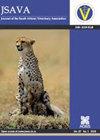Risk factors associated with the occurrence of Brucella canis seropositivity in dogs within selected provinces of South Africa
IF 0.9
4区 农林科学
Q3 VETERINARY SCIENCES
Journal of the South African Veterinary Association
Pub Date : 2019-09-25
DOI:10.4102/jsava.v90i0.1956
引用次数: 3
Abstract
The growing population of free-roaming dogs in informal communities in South Africa may increasingly place humans at risk of possible zoonotic infections including, but not limited to, Brucella canis. Worldwide, the prevalence of B. canis infection has increased during the last two centuries, resulting in increased reports of dog and human infections. This study investigated the risk factors associated with B. canis infection in dogs in three predefined areas: Gauteng, the Eastern Cape and Western Cape provinces, of South Africa. Dogs aged 7 months and older presented to welfare organisations and breeders in the study areas were selected for sampling. A comprehensive questionnaire on dog ownership, general health and vaccination status was completed prior to sampling. One blood sample of 8 mL was collected aseptically per dog. Then, equal amounts (4 mL) were transferred to the different vacutainer tubes. The 2-mercaptoethanol-tube agglutination tests were used after validation. Fifty-two dogs out of the combined sample of 1191 dogs from the three study areas tested positive for B. canis, representing an overall occurrence of 4.4%. A binomial logistic regression model was fitted to identify risk factors associated with B. canis in dogs within the study areas. Dog age (0.371; p < 0.05) and external parasite infestation (0.311; p < 0.05) were significantly associated with the B. canis infection. Ownership and sterilisation need to be further investigated as possible risk factors because both had odds ratios of 1684 and 1107, respectively, in the univariate model.南非部分省份犬布鲁氏菌血清阳性发生的相关危险因素
在南非的非正式社区中,越来越多的自由漫游的狗可能会使人类面临可能的人畜共患感染的风险,包括但不限于犬布鲁氏菌。在过去的两个世纪里,在世界范围内,犬类感染的流行率有所增加,导致狗和人类感染的报告增加。本研究调查了南非豪登省、东开普省和西开普省三个预定地区的犬类感染犬B. canis的相关危险因素。被送到福利机构和研究地区的饲养员处的7个月及以上的狗被选为样本。在抽样之前,完成了一份关于养狗、一般健康和疫苗接种状况的全面问卷调查。每只狗无菌采集血样1份,8ml。然后,等量(4ml)转移到不同的真空管中。验证后采用2-巯基乙醇试管凝集试验。在来自三个研究区域的1191只狗的总样本中,有52只狗的犬B. canis检测呈阳性,总体发生率为4.4%。拟合二项逻辑回归模型以确定研究区域内犬类感染犬B.犬病的相关危险因素。犬龄(0.371;P < 0.05)和外源寄生虫感染(0.311;p < 0.05)与犬双歧杆菌感染显著相关。所有权和绝育作为可能的危险因素需要进一步调查,因为在单变量模型中,两者的比值比分别为1684和1107。
本文章由计算机程序翻译,如有差异,请以英文原文为准。
求助全文
约1分钟内获得全文
求助全文
来源期刊

Journal of the South African Veterinary Association
VETERINARY SCIENCES-
CiteScore
1.50
自引率
0.00%
发文量
23
审稿时长
22 weeks
期刊介绍:
The Journal of the South African Veterinary Association is a contemporary multi-disciplinary scientific mouthpiece for Veterinary Science in South Africa and abroad. It provides veterinarians in South Africa and elsewhere in the world with current scientific information across the full spectrum of veterinary science. Its content therefore includes reviews on various topics, clinical and non-clinical articles, research articles and short communications as well as case reports and letters.
 求助内容:
求助内容: 应助结果提醒方式:
应助结果提醒方式:


